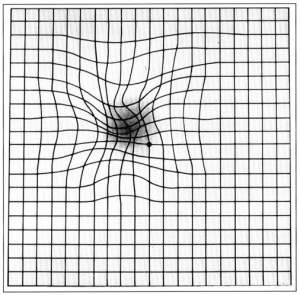Wet Macular Degeneration Treatment Toronto
What is Macular Degeneration?
Macular degeneration, also referred to as Age Related Macular Degeneration (AMD) is a degenerative condition affecting older individuals that results in central vision loss. AMD can be classified as “dry” or “wet” and is the leading cause of vision impairment in older adults. Dry AMD results in a cellular debris known as drusen that develop between the layers of the retina and cause atrophy and scarring. Wet AMD is advanced and causes blood vessels in the retinal layers to bleed fluids and exudate and cause haemorrhaging in the retina. This fluid causes severe central vision loss.
Dry Macular Degeneration
Dry AMD is an early stage of the condition and results in a debris known as drusen that develop between the layers of the retina and cause atrophy and scarring. Gradual central vision loss may occur but usually is not as severe as wet AMD. As dry AMD develops, central vision will begin to deteriorate causing distortion and eventually blind spots making it difficult to recognize faces, read or drive.
Wet Macular Degeneration
Wet AMD is advanced and causes blood vessels in the retinal layers to bleed fluids and exudate and cause haemorrhaging in the retina. This fluid causes permanent damage to the light sensitive retinal cells and causes severe central vision loss.
What are Signs and Symptoms of Macular Degeneration?
Symptoms of macular degeneration are usually gradual and painless. Symptoms may include:
- distorted vision, especially apparent while viewing straight lines
- Blurry, dark or white spots in your central vision
- Decreased or changing colour perception
Who is at Risk for Developing Macular Degeneration?
Common risk factors for AMD include:
- Ageing: Risk of developing AMD increases as you age and is most common in individuals over 65.
- Obesity and inactivity: studies demonstrate that overweight patients with AMD had double the risk of developing advanced AMD in comparison to patients with normal body weight
- Heredity: Having a family history of AMD puts you at a higher risk of developing AMD
- Hypertension (high blood pressure): Diseases that effect the circulatory system, may increase the risk of AMD
- Smoking: Studies show smoking increases the risk of developing severe vision loss by 25%.
- Caucasians and patients with light eye colour: AMD appears to be more prevalent in Caucasians and patients with lighter eye colour. It is theorized that the darker pigment on the eye has a protective factor against developing AMD from sun exposure, although there is no conclusive evidence that AMD is caused by exposure to sunlight.
- Medication Side Effects: AMD can be induced from certain medications such as Aralen, Thorazine, Mellaril, Prolixin, Trilafon, and Stelazine.
If you are at risk for developing AMD, your doctor may recommend routine use of an Amsler grid.
How is Macular Degeneration Treated?
There is no cure for macular degeneration but there are treatments that can delay progression and possibly aid in improving vision. Treatment options depend on what stage of AMD is present.
Early stage AMD or dry AMD can be treated by delaying its progression with good nutrition and supplements supplements containing omega-3 fatty acids, lutein and zeaxanthin. Many studies have revealed positive associations between good nutrition and reduced risk of developing AMD or its progression to wet AMD. Studies have also concluded an association between diets high in salmon and other cold water fish which contain high levels of omega-3 fatty acids and the prevention or reduced risk of progression of AMD.
Lucentis
Treatments for wet AMD are aimed at preventing the blood vessels from abnormal growth. Lucentis has been shown to prove vision significantly with patients who suffer from AMD. Lucentis works by inhibiting the proteins that stimulate the growth of abnormal blood vessels which cause haemorrhaging within the retina.
Lucentis is administered through monthly injections into the eye. Complications from Lucentis may include retinal detachment, traumatic cataract, increased eye pressure and inflammation within the eye.

Prevent the risk of developing AMD by eating a diet high in leafy greens and colourful fruits and veggies
How can I prevent Macular Degeneration?
There is no guarantee that you wont develop macular degeneration, but there are risk factors that you can avoid.
- Quit smoking!
- Nutritious diet high in leafy greens and colourful fruits and veggies like bell peppers.
- If approved by your physician, take a high quality multivitamin supplement.
- If you already have AMD, an AREDS-formula eye vitamin containing supplements specifically to improving AMD.
- Eat a diet high in salmon and other cold water fish or take a high quality omega-3 fish oil supplement.
- Maintain a healthy weight and live a active lifestyle.
- Reduce refined carbohydrates.
- Keep your blood pressure and cholesterol in control
- Wear protective eye wear with UV protection to protect again sun damage.
- Keep up to date with regular eye examinations.
If your ophthalmologist feels you may be at risk for AMD, it may be recommended that you routinely examine any changes to your vision using an Amsler grid. An Amsler grid is a tool used to determine if there is any distortion or vision loss that you can use in your very own home.
DOWNLOAD YOUR FREE AMSLER GRID
How to use an Amsler Grid
If you wear reading glasses, wear them while examining the Amsler grid and hold it at the same distance as you would hold a book.
- Cover one eye and focus on the dot in the centre
- Do you clearly see all four corners of the grid?
- Do any of the lines appear wavy, distorted or blurred?
- Are there areas of the grid that appear darker or missing?
- Cover the other eye and repeat the steps.
If you notice any abnormality report these changes to your ophthalmologist immediately. Routine self examination at home is a great way to track your own vision changes but routine eye examinations should still be maintained.
“He who looks through an open window sees fewer things than he who looks through a closed window.”― Charles Baudelaire





